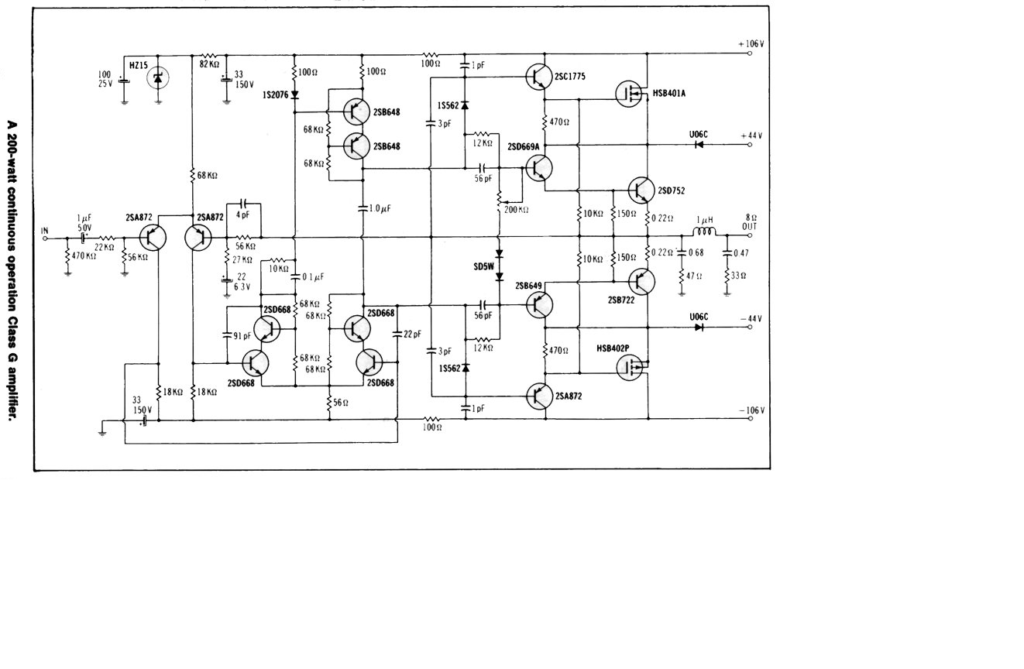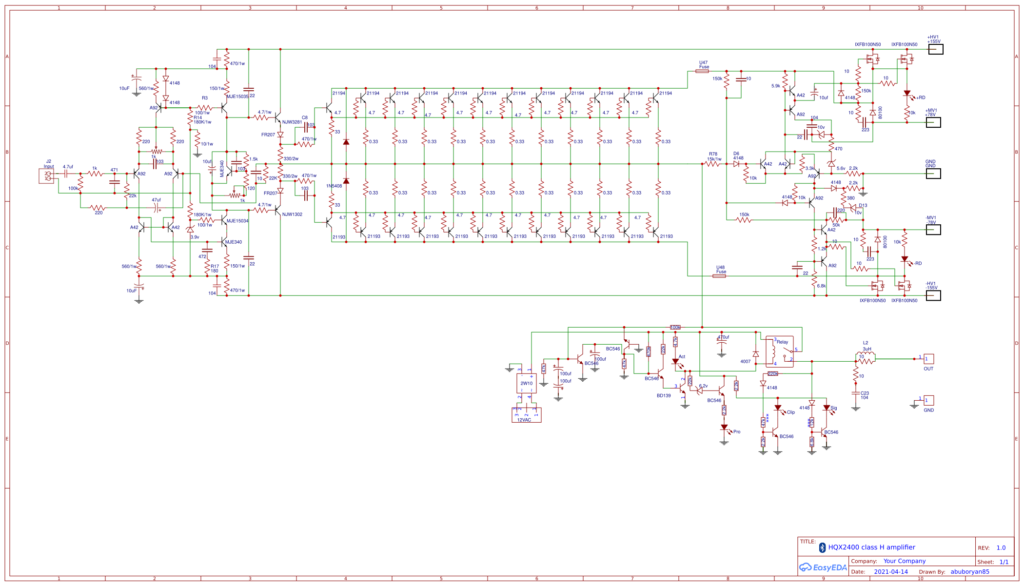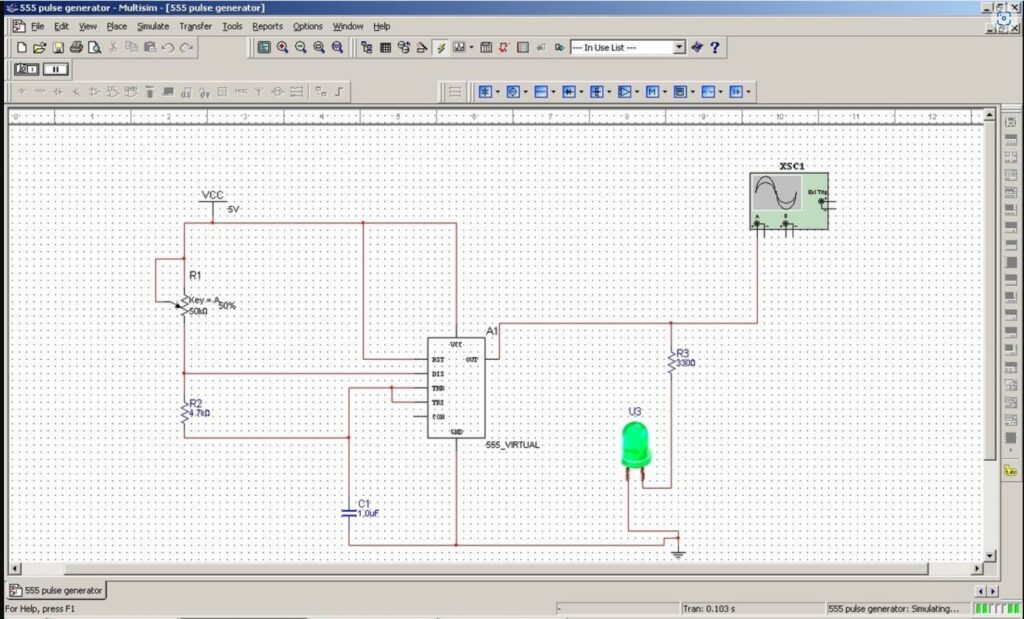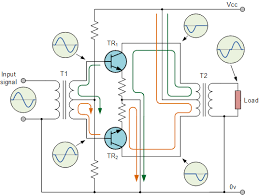Applications, Usage, and Comparisons
Introduction
Amplifiers are fundamental components in audio systems, responsible for boosting signal power to drive loudspeakers or other output devices. Amplifiers are categorized into various classes—A, B, AB, C, D, G, H, and others—each with distinct characteristics that make them suitable for specific applications. Among these, Class G and Class H amplifiers are notable for their efficiency and performance in high-power audio applications. This article explores Class G and H amplifiers, their applications, their comparative advantages and disadvantages, and how they relate to other amplifier classes.
Following is a diagram of a class G amplifier:

Class G Amplifiers: Working Principle and Applications
Working Principle
Class G amplifiers are designed to enhance efficiency by varying the supply voltage according to the input signal level. Unlike Class A and AB amplifiers, which operate with a constant supply voltage, Class G amplifiers use multiple supply rails, switching between them as needed. The primary idea behind Class G amplification is to reduce power dissipation when the signal level is low and to provide higher voltage rails only when required by a high-level signal.
A typical Class G amplifier operates with at least two voltage rails—low and high. When the signal is within a certain range, the amplifier operates on the lower voltage rail, minimizing power consumption. When the signal exceeds the threshold of the low rail, the amplifier switches to the higher voltage rail, allowing it to output the required power without distortion.
Applications of Class G Amplifiers
Class G amplifiers are widely used in applications where efficiency and heat management are critical, such as:
- High-Power Audio Amplifiers: Class G amplifiers are commonly used in professional audio systems, including concert sound systems and PA (Public Address) systems, where high power and efficiency are necessary.
- Home Audio Systems: In high-fidelity home audio systems, Class G amplifiers offer a balance between sound quality and efficiency, making them a popular choice for audiophiles.
- Automotive Audio: Due to their efficiency, Class G amplifiers are also used in automotive audio systems, where power consumption is a critical concern.
- Portable Audio Devices: Some portable audio devices incorporate Class G amplification to extend battery life while delivering high-quality sound.
Advantages of Class G Amplifiers
- High Efficiency: By switching between voltage rails, Class G amplifiers reduce power wastage and improve overall efficiency, especially at lower output levels.
- Reduced Heat Generation: The efficiency of Class G amplifiers leads to lower heat production, which is beneficial in applications where thermal management is a concern.
- Improved Sound Quality: Class G amplifiers maintain sound quality by minimizing crossover distortion, a common issue in Class B amplifiers.
Disadvantages of Class G Amplifiers
- Complexity: The design of Class G amplifiers is more complex than simpler amplifier classes, potentially leading to higher costs.
- Switching Artifacts: Although generally minimized, switching between voltage rails can introduce artifacts or noise, affecting audio quality.
Class H Amplifiers: Working Principle and Applications
Working Principle
Class H amplifiers are an evolution of Class G amplifiers, further improving efficiency by modulating the supply voltage in a continuous manner, rather than switching between fixed rails. In a Class H amplifier, the supply voltage is dynamically adjusted to follow the input signal, staying just above the required output level. This minimizes the voltage difference across the output devices, reducing power dissipation.
Unlike Class G amplifiers that switch between discrete voltage levels, Class H amplifiers modulate the supply voltage more precisely, which allows them to achieve even higher efficiency.
Following is a diagram of a class H amplifier :

Applications of Class H Amplifiers
Class H amplifiers are used in similar applications as Class G amplifiers but are preferred in scenarios where even greater efficiency is desired:
- Professional Audio Equipment: Class H amplifiers are commonly found in high-end professional audio equipment, where power efficiency and performance are paramount.
- Broadcast Transmitters: Due to their efficiency, Class H amplifiers are also used in broadcast transmitters, where they can handle large power levels with minimal heat generation.
- Power Amplifiers in Public Address Systems: Class H amplifiers are ideal for large-scale PA systems that require efficient, high-power output.
- Subwoofers and High-Power Bass Amplifiers: In applications requiring substantial power, such as subwoofers and bass amplifiers, Class H amplifiers provide the necessary performance with reduced power consumption.
Advantages of Class H Amplifiers
- Superior Efficiency: Class H amplifiers offer the highest efficiency among linear amplifiers, making them suitable for applications where power efficiency is critical.
- Lower Heat Output: By continuously adjusting the supply voltage, Class H amplifiers reduce the heat generated, which is beneficial for long-term reliability.
- Enhanced Power Handling: Class H amplifiers can handle higher power levels with less stress on the output devices, making them ideal for demanding audio applications.
Disadvantages of Class H Amplifiers
- Increased Design Complexity: The continuous modulation of supply voltage adds complexity to the design, potentially increasing costs and making the design more challenging.
- Potential for Distortion: While Class H amplifiers are designed to minimize distortion, the continuous voltage modulation can sometimes introduce subtle distortions if not properly managed.
Comparison of Class G and H Amplifiers with Other Amplifier Classes
Class G vs. Class AB Amplifiers
Class AB amplifiers are widely used in audio applications due to their balance of efficiency and sound quality. However, they operate with a fixed supply voltage, leading to greater power dissipation compared to Class G amplifiers, especially at lower output levels.
- Efficiency: Class G amplifiers are more efficient than Class AB amplifiers, particularly when handling varying signal levels.
- Sound Quality: Class AB amplifiers are known for their excellent sound quality, but Class G amplifiers can achieve similar quality with the added benefit of reduced heat generation.
Class H vs. Class D Amplifiers
Class D amplifiers, or switching amplifiers, are highly efficient and are commonly used in portable and high-power audio applications. Unlike Class H amplifiers, which are linear amplifiers, Class D amplifiers use pulse-width modulation (PWM) to achieve high efficiency.
- Efficiency: Class D amplifiers generally offer higher efficiency than Class H amplifiers, making them ideal for battery-powered devices and other energy-sensitive applications.
- Sound Quality: While Class D amplifiers are efficient, they may introduce more distortion compared to Class H amplifiers, especially in high-fidelity applications.
Class G and H vs. Class A Amplifiers
Class A amplifiers are the least efficient but are known for their superior sound quality, as they operate with a constant current and minimal distortion.
- Efficiency: Both Class G and H amplifiers are significantly more efficient than Class A amplifiers, which is particularly important in high-power applications.
- Heat Generation: Class A amplifiers generate substantial heat, while Class G and H amplifiers are designed to minimize heat production.
- Application: Class A amplifiers are typically used in high-end, audiophile-grade equipment where sound quality is the primary concern, whereas Class G and H amplifiers are favored in professional and commercial applications where efficiency is crucial.
Conclusion
Class G and H amplifiers represent significant advancements in amplifier design, offering enhanced efficiency and performance in various audio applications. While Class G amplifiers achieve improved efficiency by switching between multiple voltage rails, Class H amplifiers take this a step further by continuously modulating the supply voltage, resulting in even greater efficiency.
These amplifier classes are particularly valuable in high-power and professional audio applications, where power efficiency, heat management, and sound quality are critical. Despite their increased design complexity, the benefits they offer make them indispensable in scenarios requiring high performance and efficiency.
In comparison with other amplifier classes, Class G and H amplifiers stand out for their ability to deliver high power with minimal heat generation, making them suitable for a wide range of applications, from professional audio systems to broadcast transmitters. Their unique characteristics ensure that they remain a popular choice in the ever-evolving world of audio technology.
Ready to take a dive into Electrical Engineering to get a head start on College or University, or simply expand your DIY knowledge?
Check out our meticulously designed course in Electrical/Electronic Engineering for all walks of life, from any country. Delivered by Professor F. Tavassoli.

Join students and professionals
from across the world increasing their knowledge of Electrical Engineering.
One email at a time
We never send spam or give your information to anyone, Privacy Policy here.


